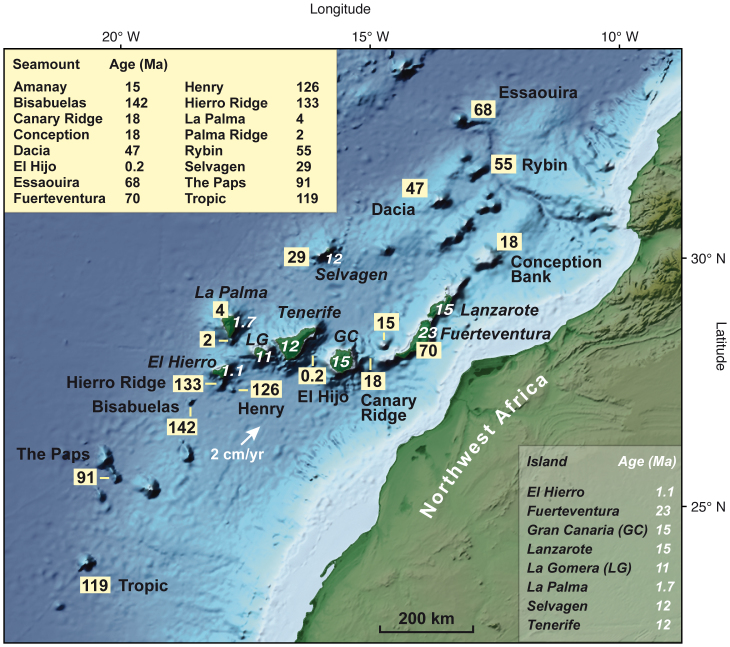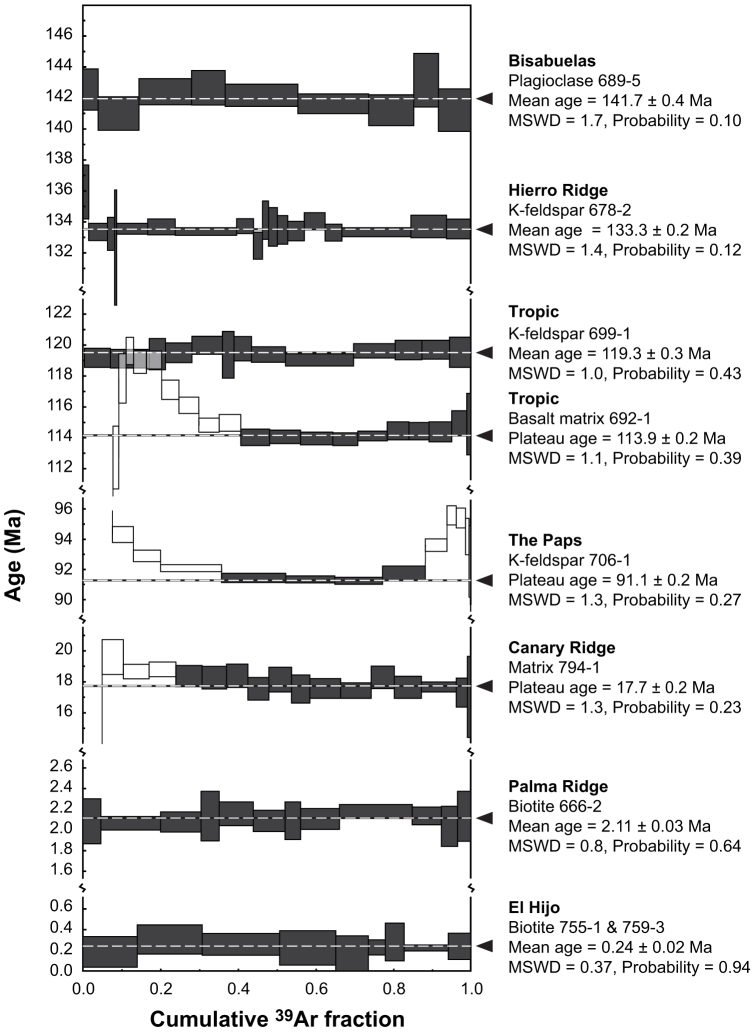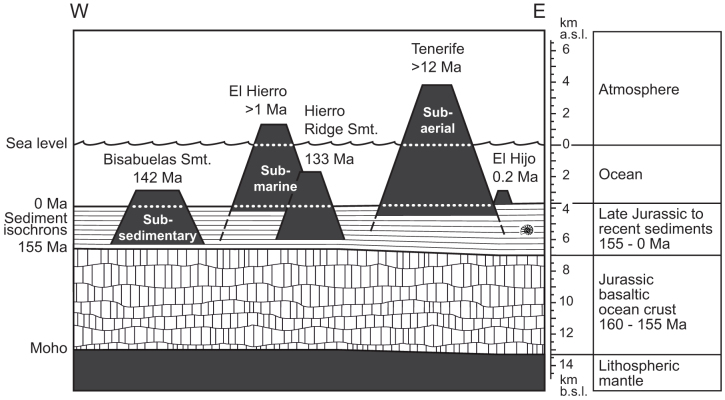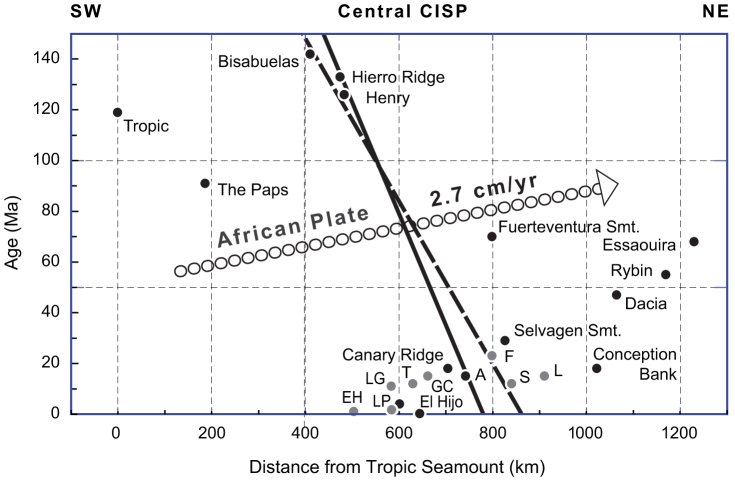Abstract
The Canary Island Seamount Province forms a scattered hotspot track on the Atlantic ocean floor ~1300 km long and ~350 km wide, perpendicular to lithospheric fractures, and parallel to the NW African continental margin. New 40Ar/39Ar datings show that seamount ages vary from 133 Ma to 0.2 Ma in the central archipelago, and from 142 Ma to 91 Ma in the southwest. Combining 40Ar/39Ar ages with plate tectonic reconstructions, I find that the temporal and spatial distribution of seamounts is irreconcilable with a deep fixed mantle plume origin, or derivation from passive mantle upwelling beneath a mid-ocean ridge. I conclude that shallow mantle upwelling beneath the Atlantic Ocean basin off the NW African continental lithosphere flanks produced recurrent melting anomalies and seamounts from the Late Jurassic to Recent, nominating the Canary Island Seamount Province as oldest hotspot track in the Atlantic Ocean, and most long-lived preserved on earth.
The Canary Island Seamount Province (CISP) comprises more than 100 seamounts, isolated volcanic structures on the seafloor ranging from small (<1000 m height) to mid-sized (>1000 m) and mid-sized explosive (<700 m water depth) to ocean islands1. It represents the easiest hotspot track to find in the northern part of the African plate2, but its location is difficult to explain, and its origin is controversial3,4,5,6. Primitive CISP basalts are derived from decompression melting of upwelling mantle that includes deep (HIMU-type), depleted (DMM-type), and enriched (EM-type) mantle components7,8,9 and erupt after limited interaction with altered MORB crust and Cenozoic sediments10. Plausible models for the formation of scattered seamount chains like the CISP include (a) deep mantle upwelling through fixed mantle plumes5, (b) shallow passive mantle upwelling beneath mid-ocean ridges11 and (c) shallow mantle convection from continental lithosphere flanks3.
Original fixed-plume models5 were based on the E-W alignment and apparent age progression of the Canary Islands from Lanzarote-Fuerteventura (15–23 Ma12) to El Hierro (<1.1 Ma13) (Fig. 1), and the assumptions that Canarian island-seamounts grow fast, and that their subaerial ages were representative of the onset of magma generation and mantle upwelling at any given site. Later studies included northeastern seamounts, and inferred a wider NE-SW-oriented fixed-plume track4 beginning near Essaouira Seamount (68 Ma) and ending around El Hierro and La Palma (<4 Ma14). Because the continental margin, palaeomagnetic anomalies and MORs, and plate motion vector run roughly parallel, a NE-SW oriented seamount chain appears compatible with either model, but the age distribution and geotectonic setting are critical. Here we look at the ages of CISP seamounts from the central archipelago to the SW, analyzing rock samples that were dredged during RV Meteor cruise M4315. For the first time, seamount age data across the entire CISP are available for consideration, and based on the spatial and temporal distribution, mantle convection models of origin can be evaluated. 40Ar/39Ar analyses were carried out by single-crystal laser fusion and laser step-heating using irradiation monitor TCR (27.87 Ma16). I start with a summary of results, from northeast to southwest (2Sigma errors).
Figure 1. Topographic map of the NW African continental margin and age distribution in the Canary Island Seamount Province (CISP).
Numbers are the oldest ages determined for seamounts and islands in millions of years. Seamount ages from this study plus additional data for Henry29, La Palma14, Fuerteventura24,25,26, Amanay34, Selvagen, Conception, Dacia, Rybin, and Essaouira seamounts4,8. Oldest subaerial island ages (white) for Lanzarote and Fuerteventura12, Gran Canaria17, Tenerife10, La Gomera35, La Palma18, El Hierro13, and Selvagen8. Map base from NOAA (ETOPO1)36. Present plate motion vector from UNAVCO model (http://www.unavco.org).
Results
Canary ridge
This seamount is part of the ridge connecting the seamount socles of Gran Canaria and Fuerteventura (Fig. 1), and yields a hornblende mean age of 17.8 ± 0.3 Ma and a matrix step-heating plateau age of 17.7 ± 0.2 Ma (Fig. 2). Note, this is ~3 m.y. older than the oldest subaerial “shield-stage” lavas of overlying Gran Canaria (~15 Ma17).
Figure 2. 142 million years of Canarian seamount volcanism in 40Ar/39Ar age spectra.
Apparent ages from sequential single-crystal total fusions and step-heating analyses are plotted against cumulative 39Ar fractions. Accepted analyses and plateau steps are black. Box heights are ±2σ. Inverse-variance weighted mean ages are statistically valid, as indicated by low Mean Square Weighted Deviates (MSWD) and sufficient Probabilities (>0.05)37,38. Mean age errors are 2σ and include uncertainties in J-values. Note breaks in age scale. See text and Supplementary Information S3 and S4 for more data and diagrams.
El hijo
A 600 m high young seamount15 lies in the channel between Gran Canaria and Tenerife. Biotite phenocrysts of its trachyandesite lava samples 755-1 and 759-3 yield a weighted mean age of 0.24 ± 0.02 Ma (Fig. 2).
Palma ridge
This seamount is in the southern submarine flanks of La Palma. Biotites from phonolite lava 666-2 yield a mean age of 2.11 ± 0.03 Ma, younger than the uplifted seamount series of northern La Palma (≤4 Ma14) but older than the subaerial volcanics of the island (<1.7 Ma18). There is a Pliocene evolved seamount in the submarine structure of southern La Palma.
Hierro ridge
In the flanks of El Hierro, a seamount ridge extends ~30 km south. Its trachyte breccia sample 678-2 yields a mean K-feldspar age of 133.3 ± 0.2 Ma, reproduced by a mean hornblende age of 133.8 ± 0.6 Ma. The submarine structure of El Hierro includes an Early Cretaceous seamount, overlain by later El Hierro volcanics at its northern flank.
Bisabuelas
A small group of seamounts located 70 Km southwest of El Hierro was named “Las Hijas” (The Daughters) and suspected to represent juvenile future Canary Islands19. Eight plagioclase single-crystal analyses of its trachyte sample 689-2 yield a mean age of 140.5 ± 0.7 Ma. Nine plagioclase crystals from trachyte sample 689-5 yield a mean age of 141.7 ± 0.4 Ma. This is probably the oldest seamount in the Atlantic Ocean. Whether its origin is Early Cretaceous or Late Jurassic depends on the age of the submerged seamount structure, which is likely a few million years older than 142 Ma, and uncertainties of the Jurassic-Cretaceous chronostratigraphic boundary (e.g. 142 ± 2 Ma20). Bisabuelas (Great-grandmothers) is suggested as an alternative provisional name for this seamount group.
The paps
This seamount group is located ~300 km southwest of El Hierro. K-feldspar microphenocrysts from trachyphonolitic pumice breccia 706-1 yield a step-heating age spectrum with disturbances in the low- and high-temperature regions, indicating partial alteration (Fig. 2). The plateau in-between comprises >52% of the 39Ar released and yields a plateau age of 91.1 ± 0.2 Ma.
Tropic
Tropic seamount is at the southwestern edge of the CISP. Thirteen K-feldspar phenocrysts from basal sample 699-1 yield a mean age of 119.3 ± 0.3 Ma. Seven plagioclase crystals from topmost trachyte sample 693-2 yield a mean age of 115.6 ± 0.5 Ma. Twentythree anorthoclase phenocrysts from trachyte sample 692-3 yield a mean age of 116.3 ± 0.2 Ma, reproduced by 10 hornblende analyses (116.6 ± 0.5 Ma), and matrix step-heating yields a plateau age of 113.9 ± 0.2 Ma for basalt sample 692-1. All samples are from the southwestern slopes and all ages are significantly higher than plagioclase K-Ar ages from the northern slope (84 to 59 Ma21). Tropic Seamount erupted from 119 Ma to 114 Ma with possible late stage eruptions until ~60 Ma.
Discussion
Depending on the rate, duration and frequency of magma supply from melting anomalies, and the age and depth of origin, Canary seamounts grow from the Late Jurassic to Recent ocean floor towards or beyond sea level. The bulk thickness of sediments covering the basaltic oceanic crust basement (~155 Ma old around palaeo–magnetic anomaly M2522) is known from reflection seismics as at least 2,500–3,000 m, e.g. NE of Tenerife and SE of El Hierro23. At ages up to 142 Ma, Canarian seamounts are partly burried in this sedimentary sequence. Consequently, many seamounts are much larger than meets the eye or remote sensors, and subaerial, submarine and subsedimentary sections need to be considered to constrain seamount dimensions and to understand structural relationships. Two examples (Fig. 3):
Figure 3. Schematic cross section of selected seamount settings.
Thickness and depth of basaltic ocean crust (~155 Ma around anomaly M2522) and bulk thickness and depth of sediments from reflection seismics23,27. Sediment isochrons (155 to 0 Ma) schematically. To keep it simple, seamount subsidence due to lithosphere loading, magmatic plumbing systems, and interlocking of seamount clastic aprons and sediment sequence are not considered in this sketch. Subaerial and submarine seamount heights are precise, subsedimentary seamount heights are minimum estimates, especially for Tenerife. See text for discussion.
Bisabuleas seamount rises to 2850 m.b.s.l. above the seafloor, which levels at ~3850 m.b.s.l. in the vicinity. Considering that ~3,000 m of sediment were deposited on the sea floor and seamount flanks from 142 Ma to recent, Bisabuelas seamount must be at least 4,000 m tall, and only a quarter is peeking out of the sediment.
El Hierro, the second example, rises to 1,500 m.a.s.l. from ~3,900 m.b.s.l. In addition, Hierro Ridge seamount reaches from 1500 m.b.s.l. down to at least 6,000 m.b.s.l., estimating ~2,500 m of sediment since the Early Cretaceous. Accepting Hierro Ridge as integral part of El Hierro's seamount sub-structure, 2,500 m subsedimentary height add to the submarine-subaerial height of 5,400 m, transforming the youngest and smallest Canary Island into one of the oldest (>133 Ma) and tallest (>7,900 m) Canary Island seamounts.
The new 40Ar/39Ar dates provide evidence for both a much prolongued history of the CISP and of individual seamounts, and for a composite structure and multi-stage origin of subaerially young and supposedly fast-grown13 islands. The riddle of Miocene to Pleistocene islands in the center of an essentially Cretaceous seamount field (Fig. 1) may have a simple answer: Only the subaerial island tips of these giant seamounts are young, their seamount roots can be Early Cretaceous or older. As yet, only a few seamount sub-structures were revealed, however, by falling sea levels (Selvagen: >29 Ma8), by tectonic uplift (Fuerteventura: >70 Ma24,25,26) or by dredging (El Hierro: >133 Ma). The proof of widespread Late Jurassic to Mid Cretaceous seamount volcanism in the CISP has significant consequences for seismic and sedimentary facies models27 and mantle convection models, which were based on an initiation of CISP volcanism and supply of volcanic sediments to basins in the Late Cretaceous to Early Paleogene.
An age progression from the SW to the NE is conditio sine qua non for a fixed-plume origin of the CISP, given that the African plate moves to the NE1,4,28. The new 40Ar/39Ar ages show that seamounts do not grow systematically older from the southwest (Tropic, 119 Ma) to the northeast (Essaouira, 68 Ma) (Fig. 1). Canarian seamounts are “old” in the southwestern, “old and young” in the central and “intermediate” in the northeastern province (Fig. 4). Even if the African plate had moved in reverse, this would not constitute an appropriate age progression. The temporal and spatial distribution of Canary seamounts is irreconcilable with single fixed-plume models.
Figure 4. No proper age progression in the CISP.
Oldest ages of seamounts (black) and islands (grey) versus distance from Tropic Seamount along a SW-NE transect. Dotted line indicates average vector of the African Plate during the past 100 m.y. Seamount distribution should be aligned parallel to this vector (youngest in the SW, oldest in the NE) if derived from a fixed plume. Naive linear regression attempts yield poor solutions for the seamount data set (dashed line, R2 = 0.20) and data set including subaerial island data (solid line, R2 = 0.13), indicating a scattered age distribution, and lack of a significant and systematic age progression. A = Amanay Smt., EH = El Hierro, LP = La Palma, LG = La Gomera, T = Tenerife, GC = Gran Canaria, F = Fuerteventura, S = Selvagen, L = Lanzarote (for additional age data sources see Fig. 1).
Shallow recycling of continental lithosphere into passively upwelling mantle beneath mid-ocean ridges can explain the origin of diffuse seamount chains in young ocean basins when seamount formation closely follows an MOR11. Plate tectonic reconstructions show, however, that the Atlantic MOR veers away orthogonally from the CISP. When Bisabuelas erupted, the MOR was already ~200 km away and the seamount erupted on an ocean floor >10 m.y. older than the seamount (palaeomagnetic anomaly M25) (Fig. 5). Still during the Early Cretaceous, at least three more large seamounts erupted to the east and west (Hierro Ridge 133 Ma, Henry 126 Ma29, Tropic 119 Ma). By the K-Pg boundary the latest, the CISP had reached its present dimensions with eruptions from The Paps (91 Ma), Fuerteventura (>70 Ma), and Essaouira (68 Ma), but the MOR had veered another 1,200 km to the NW (Fig. 5). An origin of the entire CISP from passive mantle upwelling beneath the mid-Atlantic ridge is also not reasonable.
Figure 5. Mantle upwelling and CISP follow the NW African continental margin.
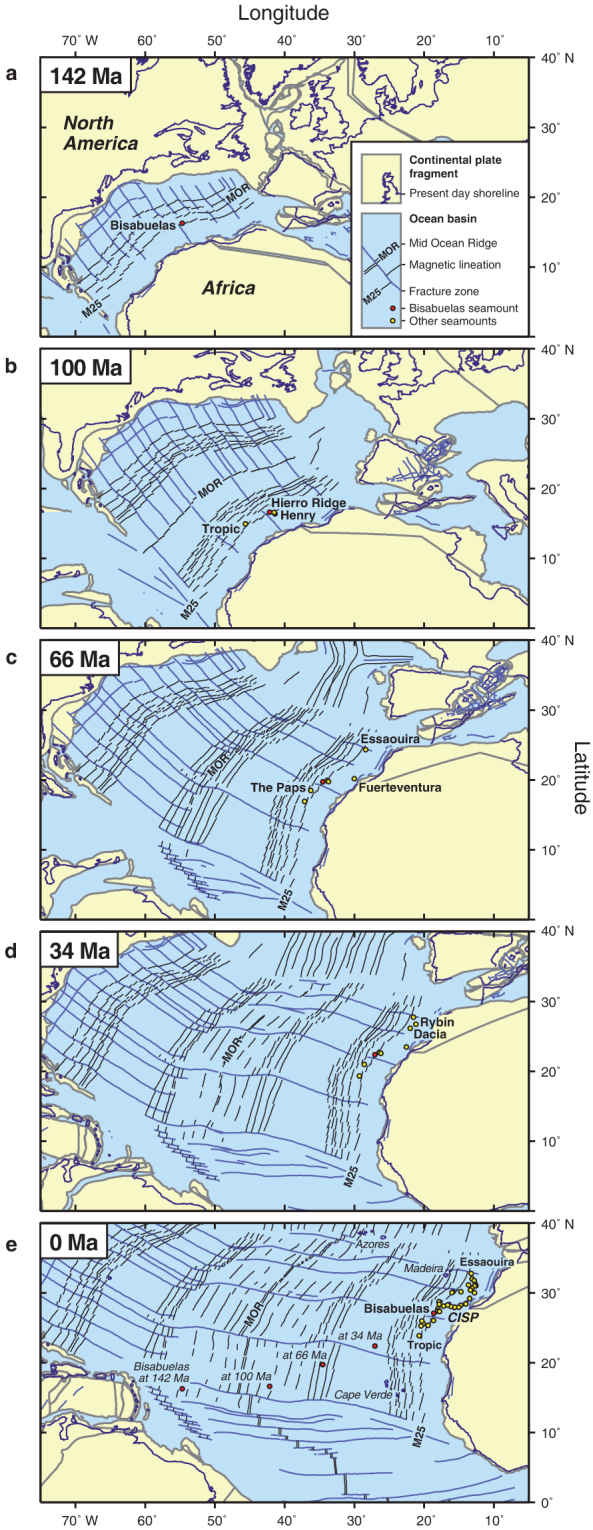
(a–e), Plate tectonic reconstructions and setting of CISP seamounts at 142 Ma (a), 100 Ma (b), 66 Ma (c, K-Pg boundary), 34 Ma (d), and Present (e). Maps created by the author with ODSN Advanced Plate Tectonic Reconstructions (http://www.odsn.de) The reconstructions show that the CISP started to form near palaeomagnetic anomaly M25 no later that 142 m.y. ago, when the North American and African continents were only 900 km apart (a). With the African Plate (continent plus new ocean crust) drifting primarily eastward, the MOR veering away to the NW and the North Central Atlantic opening up, more seamounts erupted at equal distance from the rifted NW African continental margin, scattered along palaeomagnetic anomaly M25 (b–c). At the latest from the K-Pg boundary (c) the outlines of the CISP have not changed significantly. Later seamounts fill up the space between Tropic and Essaouira (d). Figure (e) shows the present spatial distribution of all large seamounts in the CISP, including islands and unnamed and undated ones (see Fig. 1 for details). Future studies will show how many of these are actually much older, and should really be plotted in (a–d). The coordinates of Bisabuelas Seamount, as projected from (a–d) onto (e), illustrate the path taken by the African plate (central CISP range) from 142 Ma to Present. This is what a hotspot track should look like, if a deep fixed-plume mantle upwelling had ever existed beneath the central CISP at 142 Ma or later. Instead, mantle upwelling and CISP follow the African plate on its 3000 km journey to the E-NE, indicating that mantle convection is causally related and physically connected to the moving plate, its continental lithospheric roots respectively.
Of the three competing mantle convection models1,3,11, only shallow mantle convection at the rifted continental lithosphere flanks can explain the alignment, age distribution, plate tectonic setting and long history of individual centers of the CISP, and agrees with the observed mix7,8,9,10 of geochemical mantle components. Breakup of the Pangaean continent exposed >250 km thick cratonic lithosphere to hot asthenospheric mantle and caused mantle upwelling (edge-driven convection)3 beneath the juvenile ocean crust (MORB) and recycling of subcontinental lithosphere (EM-type mantle). Seamount formation started less than 40 m.y. after the earliest rifting in the North Central Atlantic (~184 Ma25), when ocean crust formation was barely advanced (i.e. the process producing depleted DMM-type mantle) and HIMU-type mantle components were ambiant to dominant in the asthenosphere beneath the young Atlantic ocean basin and lithosphere.
While the origin of the entire CISP from shallow plate-bound mantle convection off the rifted NW African continental margin is fully compatible with the geochemical composition, spread and age of seamounts, and plate tectonic reconstructions, the present data set does not rule out the possibility of more complex scenarios such as alternating mantle plume and plate-related convection analogue to the Samoan hotspot system30, or multiple, successive, mantle plumes similar to “hot spot highways” in the Pacific31. Even hybrid models combining early passive mantle upwelling near the MOR in the Late Jurassic with shallow edge-driven convection throughout the Cretaceous and the appearance of a single deep-fixed plume in the Early Paleogene are imaginable. Prerequisites, however, to explain the origin of the CISP and the temporal and spatial distribution of its seamounts, these scenarios are not.
The conditions of formation of CISP-type seamount chains (shallow source, juvenile astenosphere, slow plate, low production rate32, recurrent mantle upwelling and melting anomalies beneath the same plate segment) are fundamentally different from fixed-plume prototypes like the Hawaii-Emperor chain (deep source, mature astenosphere, high production rate, fast plate, rapid decoupling of melting anomalies from upwelling source)33, yet seamount dimensions are comparable. I conclude that plate-bound shallow mantle convection is an important mechanism of seamount formation in young ocean basins bordered by rifted continental margins, and is capable of sustaining extremely long-lived hotspot tracks, for at least 142 m.y. in case of the Canary Island Seamount Province.
Methods
16 mineral and matrix separates from 12 dredged rock samples from RV Meteor cruise M43 were analyzed by 40Ar/39Ar laser step-heating and single-crystal fusion. Crystals (plagioclase, K-feldspar, hornblende, biotite) and matrix particles were hand-picked from crushed and sieved rock splits (250–500 μm). To remove alteration surfaces and adhering matrix material, feldspar separates were etched in 15% hydrofluoric acid for 5 minutes. All samples were washed and cleaned using an ultrasonic disintegrator. Separates were irradiated in aluminum trays and cans lined by cadmium foil at the 5-MW reactor of the GKSS Research Center (Helmholtz Centre Geesthacht, Germany). The neutron flux was monitored using Taylor Creek Rhyolite Sanidine (27.87 ± 0.04 Ma16). 40Ar/39Ar laser analyses were carried out at the GEOMAR Geochronology Lab using a 20 W SpectraPhysics Argon-Ion laser and an MAP 216 series noble gas mass spectrometer. Ar Isotope ratios from mass spectrometry were corrected for mass discrimination, background and blank values, J-value gradients, and interfering neutron reactions on Ca and K.
The step-heating and single-crystal data are evaluated in age spectra (apparent age and error vs. cumulative 39Ar in order of analysis) trying to detect plateaus (>3 consecutive steps comprising >50% of the 39Ar released, with ages overlapping within 2Sigma errors), and single-crystal populations with ages overlapping within 2Sigma errors. Plateau ages represent the inverse-variance weighted mean of the plateau step ages and errors. Statistical validity of mean ages are tested by calculating the MSWD (mean square weighted deviates) and POF (probability of fit; should be >0.05 at 2Sigma/95% confidence levels)37. Because marine rock samples are generally variably altered, the degree of alteration is monitored via alteration indices based on the measured 36Ar/37Ar ratios (plagioclase, hornblende, matrix) or measured 36Ar/39Ar ratios (K-feldspar, Biotite) following established methods38. Low-temperature heating steps generally yield 10 to 100 times higher alteration indices, but are not included in the plateau age calculations. Few crystals that yield deviating apparent ages and alteration indices are also excluded from the single-crystal mean age calculations. Results are summarized in Supplement Table S2. Full analytical data are given in Supplement Table S3. Isotope correlation diagrams, age spectra, Ca/K ratios and atmospheric 40Ar contents are shown in Supplement Figures S4.
Supplementary Material
Supplementary files
Acknowledgments
I thank Claudia Benecke for moral support; Jan Sticklus for analytical support; and the Deutsche Forschungsgemeinschaft (DFG) for financial support (Project BO 912/8-1).
References
- Staudigel H. & Clague D. A. The geological history of deep-sea volcanoes. Biosphere, hydrosphere, and lithosphere interactions. Oceanography 23, 58–71 (2010). [Google Scholar]
- Morgan J. W. & Morgan J. P. in Plates, Plumes, and Planetary Processes (eds Foulger G., & Jurdy D. M.) GSA special paper 430, 65–78 (2007). [Google Scholar]
- King S. D. & Ritsema J. African hot spot volcanism: small-scale convection in the upper mantle beneath cratons. Science 290, 1137–1140 (2000). [DOI] [PubMed] [Google Scholar]
- Geldmacher J., Hoernle K. A., van den Bogaard P., Duggen S. & Werner R. New 40Ar/39/Ar age and geochemical data from seamounts in the Canary and Madeira volcanic provinces: Support for mantle plume hypothesis. Earth Planet. Sci. Lett. 237, 85–101 (2005). [Google Scholar]
- Morgan W. J. Hot spot tracks and the early rifting of the Atlantic. Tectonophysics 94, 123–139 (1983). [Google Scholar]
- Carracedo J. C. et al. Hotspot volcanism close to a passive Continental margin: the Canary Islands. Geol. Mag. 135, 591–604 (1998). [Google Scholar]
- Hoernle K. A., Tilton G. & Schmincke H. U. The Sr-Nd-Pb isotopic evolution of Gran Canaria: Evidence for shallow enriched mantle beneath the Canary Islands. Earth Planet. Sci. Lett. 106, 44–63 (1991). [Google Scholar]
- Geldmacher J., Hoernle K. A., van den Bogaard P., Zankl G. & Garbe-Schönberg D. Earlier history of the >70-Ma-old Canary hotspot based on the temporal and geochemical evolution of the Selvagen Archipelago and neighboring seamounts in the eastern North Atlantic. J. Volcanol. Geotherm. Res. 111, 55–87 (2001). [Google Scholar]
- Gurenko A. A., Sobolev A. V., Hoernle K. A., Hauff F. & Schmincke H. U. Source components of the Gran Canaria (Canary Islands) shield stage magmas: evidence from olivine composition and Sr-Nd-Pb isotopes. Contrib. Mineral. Petrol. 159, 689–702 (2010). [Google Scholar]
- Thirlwall M. F., Jenkins C., Vroon P. Z. & Mattey D. P. Crustal interaction during construction of oceanic islands: Pb-Sr-Nd-O isotope geochemistry of the shield basalts of Gran Canaria, Canary islands. Chem. Geol. 135, 233–262 (1997). [Google Scholar]
- Hoernle K. et al. Origin of Indian Ocean seamount province by shallow recycling of continental lithosphere. Nature Geosci. 4, 883–887 (2011). [Google Scholar]
- Coello J. et al. Evolution of the eastern volcanic ridge of the Canary Islands based on new K-Ar data. J. Volcanol. Geotherm. Res. 53, 251–274 (1992). [Google Scholar]
- Guillou H., Carracedo J. C., Perez Torrado F. & Rodriguez Badiola E. K-Ar ages and magnetic stratigraphy of a hotspot-induced, fast grown oceanic island: El Hierro, Canary Islands. J. Volcanol. Geotherm. Res. 73, 141–155 (1996). [Google Scholar]
- Staudigel H., Feraud G. & Giannerini G. The history of intrusive activity on the island of La Palma (Canary Islands). J. Volcanol. Geotherm. Res. 27, 299–322 (1986). [Google Scholar]
- Schmincke H. U. & Graf G. DECOS/OMEX II, Cruise No. 43, 25 November 1998–17 January 1999. Meteor Reports, 2000-1 (Univ. Hamburg), 1–99 (2000). [Google Scholar]
- Lanphere M. A. & Dalrymple G. B. First-principles calibration of 38Ar tracers; implications for the ages of 40Ar/39Ar fluence monitors. U. S. Geological Survey Prof. Paper 1621, p. 10 (2000). [Google Scholar]
- van den Bogaard P. & Schmincke H. U. in Proceedings ODP Scientific Results 157 (eds Weaver P. P. E., Schmincke H. U., Firth J. V., & Duffield W. A.) 127–140 (College Station, 1998). [Google Scholar]
- Guillou H., Carracedo J. C. & Duncan R. A. K-Ar, 40Ar/39Ar ages and magnetostratigraphy of Brunnes and Matuyama lava sequences from La Palma Island. J. Volcanol. Geotherm. Res. 106, 175–194 (2001). [Google Scholar]
- Rihm R., Jacobs C. L., Krastel S., Schmincke H. U. & Alibes B. Las Hijas Seamounts - the next Canary Islands? Terra Nova 10, 121–125 (1998). [Google Scholar]
- Bralower J. J., Ludwig K. R., Obradovich J. D. & Jones V. Berriasian (Early Creatceous) radiometric ages for the Grindstone Creek section, Sacramento Valley, California. Earth Planet. Sci. Lett. 98, 62–73 (1990). [Google Scholar]
- Blum N., Halbach P., Münch U. & van Gerven M. Pb-Sr-Nd Isotopic Data of Mesozoic Ocean Island Basalts from the Eastern Atlantic Ocean Continental Margin. Chem. Erde 56, 193–205 (1996). [Google Scholar]
- Müller R. D., Roest W. R., Royer J.-Y., Gahagan L. M. & Sclater J. G. Digital isochrons of the world's ocean floor. J. Geophys. Res. 102, 3211–3214 (1997). [Google Scholar]
- Watts A. B. et al. A seismic study of lithospheric flexure in the vicinity of Tenerife, Canary Islands. Earth Planet. Sci. Lett. 146, 431–447 (1997). [Google Scholar]
- Le Bas M. J., Rex D. C. & Stillman C. J. The early magmatic chronology of Fuerteventura, Canary Islands. Geol. Mag. 123, 287–298 (1986). [Google Scholar]
- Steiner C., Hobson A., Favre P. & Stampli G. M. Early Jurassic sea-floor spreading in the central Atlantic – The Jurassic sequence of Fuerteventura (Canary Islands). Geol. Soc. Am. Bull. 110, 1304–1317 (1998). [Google Scholar]
- Balogh K., Ahijado A., Casillas R. & Fernandez C. Contribution to the chronology of the Basal Complex of Fuerteventura, Canary Islands. J. Volcanol. Geotherm. Res. 90, 81–101 (1999). [Google Scholar]
- Collier J. S. & Watts A. B. Lithospheric response to volcanic loading by the Canary Islands: constraints from seismic reflection data in their flexural moat. Geophys. J. Int. 147, 660–676 (2001). [Google Scholar]
- Duncan R. A. Hotspots in the southern oceans – An absolute frame of reference for motion of the Gondwana continents. Tectonophysics 74, 29–42 (1981). [Google Scholar]
- Klügel A., Hansteen T. H., van den Bogaard P., Strauss H. & Hauff F. Holocene fluid venting at an extinct Cretaceous seamount, Canary archipelago. Geology 39, 855–858 (2011). [Google Scholar]
- Koppers A. A. P. et al. Age systematics of two young en echelon Samoan volcanic trails. Geochem. Geophys. Geosyst. 12, 1–40 (2011) Q07025, doi:10.1029/2010GC003438. [Google Scholar]
- Jackson M. G. et al. Samoan hot spot track on a “hot spot highway”: Implications for mantle plumes and a deep Samoan mantle source. Geochem. Geophys. Geosyst. 11, 1–24 (2010) Q12009, doi:10.1029/2010GC003232. [Google Scholar]
- Ancochea E. et al. Constructive and destructive episodes in the building of a young oceanic Island, La Palma, Canary Islands, and genesis of the Caldera de Taburiente. J. Volcanol. Geotherm. Res. 60, 243–262 (1994). [Google Scholar]
- Coombs M. L., Eakins B. W. & Cervelli P. F. Growth and collapse of Hawaiian Volcanoes. J. Volcanol. Geotherm. Res. 151, 1–318 (2006). [Google Scholar]
- Ancochea E. & Huertas M. J. Age and composition of the Amanay Seamount, Canary Islands. Marine Geophys. Res. 24, 161–169 (2003). [Google Scholar]
- Ancochea E., Hernan F., Huertas M. J., Brändle J. L. & Herrera R. A new chronostratigraphical and evolutionary model for La Gomera: implications for the overall evolution of the Canarian Archipelago. J. Volcanol. Geotherm. Res. 157, 271–293 (2006). [Google Scholar]
- Amante C. & Eakins B. W. ETOPO1 1 Arc-Minute Global Relief Model: Procedures, Data Sources and Analysis. NOAA Technical Memorandum NESDIS NGDC 24 (2009). [Google Scholar]
- Baksi A. K. Re-evaluation of plate motion models based on hotspot tracks in the Atlantic and Indian oceans. Journal of Geology 107, 13–26 (1999). [Google Scholar]
- Baksi A. K. in Plates, Plumes, and Planetary Processes (eds Foulger G., & Jurdy D. M.) GSA special paper 430, 285–303 (2007). [Google Scholar]
Associated Data
This section collects any data citations, data availability statements, or supplementary materials included in this article.
Supplementary Materials
Supplementary files



